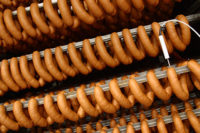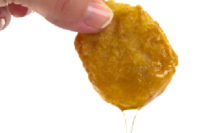
Most whole-muscle products today are made using a process that is called either tumbling, massaging or mixing. Regardless of the name of the process, the main idea is to apply a physical treatment, which allows for adequate cure migration and produces sufficient protein exudates, without causing extensive physical damage to the meat. The mechanical action of tumbling/massaging is a time-work intensity relationship. The length of time required depends upon the intensity of the physical treatment imparted to the pieces of meat. To an extent, the more intense the mechanical working, the less time required.
Many different theories exist concerning the length of the tumbling/massaging treatments. Many believe a much shorter tumbling treatment is adequate to produce a desirable product. Shorter tumbling treatments may be sufficient for an acceptable bind but longer treatments may be necessary to obtain any significant yield and quality advantage, such as improved cured color. Periodic rest periods within the tumbling treatment are important to allow time for adequate cure migration while preventing excessive muscle destruction, which could result from a continuous process and may allow for dissipation of foam in the exudate in the case on non-vacuum tumblers.
An alternative approach to the periodic rest periods of massagers and tumblers would be to tumble or mix continuously for a couple of hours, followed by a rest period of 18 to 24 hours in a separate combo bin, ending with a final mixing until sufficient exudate is produced. This approach may give sufficient mechanical action while allowing adequate time for distribution and action of brine ingredients without tying up tumblers and mixers for long periods of time. One must keep in mind that cycle and total treatment times will vary among pieces of equipment so every processor needs to experiment with the equipment available to determine an optimum processing cycle for the desired product.
An important purpose of tumbling and massaging is to solubilize and extract myofibrillar proteins to produce a protein exudate on the surface of the meat. This exudate binds the formed pieces together upon heating. At the salt levels commonly used in curing meats it is primarily the myofibrillar proteins, especially myosin, that act to bind meat pieces. The results of tumbling and massaging are not produced by the mechanical treatment alone, but with the addition of salt and alkaline phosphates.
Salt, when added alone to meat, increases the amount of water absorbed by proteins when muscle is at or above pH 6 by decreasing the isoelectric point. Myosin is easily extracted by salt solutions (up to 3 percent by weight) in pre-rigor muscle but is not split from the post-rigor or actomyosin complex by salt alone.
The addition of phosphates seems to be primarily responsible for the solubilization of myofibrillar proteins in post-rigor muscle. Alkaline phosphates aid in the solubilization of proteins even without salt, yet salt and tumbling enhance this solubilization of proteins. Furthermore, alkaline phosphates significantly reduce cooked losses when added to whole-muscle products. With the improvement of the solubility of tetrasodium pyrophosphate, I would recommend increasing the percentage of this phosphate in your phosphate blend, as it is the best phosphate at extracting proteins. However, excessive tumbling of product that contains maximum levels of phosphates can result in a rubbery texture in product.
Product should be stuffed within 30 minutes after the mechanical action stops, to prevent difficulty in stuffing and poor finished product appearance, due to the stiffening of the resting muscles at cold temperatures.


